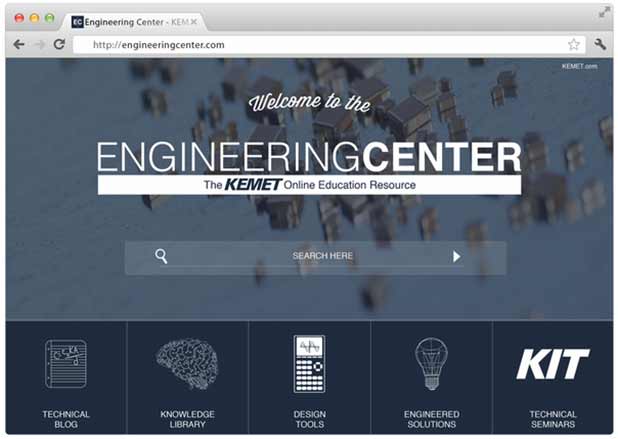Introduction
What’s the difference between the types of ferrite cores used in an inductor? Does the wire shape matter? Why should I use an X5R ceramic capacitor instead of a polymer tantalum capacitor? These are some typical questions an engineer faces when trying to find a specific inductor or capacitor for a design.
Engineers learn in school about the basics of passive circuit elements like resistors, capacitors, and inductors. Their curriculum is focused on using the “ideal” or hypothetical versions of these components. So it is no surprise that an engineer will be confused when trying to find the right part for his or her design. What’s an engineer to do?
To try to fill the gap between the theory of how a component works and which one to choose, engineers often look to component manufacturers for the answers. Unfortunately, when manfucturers provide engineers raw technical data about multiple product lines, it just adds more confusion than it resolves. Also, a manufacturer’s general product catalogs really don’t help answer questions either, as seldom is there enough detail. And the presentation the engineer saw at the last annual technical conference… isn’t much help when they forget about it months later.
The engineers I work with up and down the component supply chain will instead go to the Internet, search for key components, and go immediately to customer web sites for detailed information.
Helping engineers find this information goes beyond just a list of web-based application notes. There are different types of engineers looking for different types of information. For example, I also know through my travels that younger engineers prefer to watch videos on a specific topic while more seasoned professionals just want the nitty gritty, deep dive technical material. That is why supplying a mix of this content is crucial… there isn’t just “one kind of engineer.”
Furthermore, the information an engineer needs at an automotive company is likely different than one from the medical industry. Segmenting useful information based on an engineer’s circuit application, end-market space, and type of design is exactly what they need.
Engineers are key to shaping the world we live in with new electronics designs. With limited time, getting an engineer’s attention to get them the right information can be difficult. Clearly manufacturers that help engineers understand how to choose parts for a design, and not just part numbers, will have the advantage in the market.
This isn’t a therortical concept either, some manufactuers, like KEMET are already headed in this direction.
KEMET’S New Engineering Website is Moving the Market Forward
With over 30 PhDs, 500 engineers, and a global team of Field Application Engineers, it didn’t take long for KEMET to determine what their engineering customers needed in a website. What began with a project to answer the simple question, “Wouldn’t it be nice if there was a way to have your technical questions about passive components answered?” ended with a new section of the KEMET website titled “Engineering Center.”
Figure 1.1: KEMET’s New Engineering Website

Source: Courtesy of KEMET
KEMET’S Research Revelas Patterns
Three major engineering roles of almost every design team were identifed by KEMET’s research: the engineering manager, the seasoned design engineer, and the recent college hire. Typically, an engineering manager has a combination of a business and engineering education, and will have spent time working as an engineer before being promoted to a team leader or section manager. Also, many do not practice design on a day-to-day basis, and often act as translators between business teams and their engineering teams.
Seasoned design engineers have mastered, or are on their way to mastering, a specific domain area like Power, RF, or Digital. These engineers can be thought of as architects for the product design cycle, making high level direction and guiding the implementation with the less seasoned engineers.
Fresh out of school with a head full of equations, a heart full of ideas, and no idea what to do with any of it are the eagar young engineers. They are mentored by their more seasoned counter parts, but constantly feel the pressure to fill that knowledge gap between their veteran peers. Younger engineers want enough information on a subject so that they can converse with the more experienced design team, which is why easy access to web-based short-form content like videos or high-level application notes are favored by them.
KEMET understands these engineering roles and has designed a knowledge base that targets each of these engineer types across multiple markets and disciplines. With Engineering Center, there is a wealth of information I just have not seen from other manufacturers.
KEMET Blogs You Can Use
Blogs on KEMET’s Engineering Center are authored by KEMET’s experienced team of FAEs, who are in direct contact with their engineers and know their wants and needs. Every electrical engineer has a story of when a seemingly complex issue was solved within minutes of speaking to a manufacturer’s talented FAE. So when there’s a problem that one of KEMET’s capacitor FAEs sees on a regular basis, it will find its way into a blog post on the KEMET Engineering website. That means an answer to your question could now be as easy as a Google search or already in your RSS feed.
Each week, KEMET’s team brings new content for all levels of engineers covering everything from questions on ceramic capacitors, a video on KEMET’s technology found in their worldwide Innovation Centers, to updates on their latest design tools.
KEMET Design Tools that Help
Design calculators are an engineer’s favorite shortcut. Early design tools were as “simple” as meticulously generated look-up tables. Those tables quickly evolved into spreadsheet-based macros and today, interactive web-based Javascript calculators. One such tool available on KEMET’s Engineering Center is WebSPICE, a simulation tool that simulates the expected behavior of capacitors under an application’s voltage, temperature, and frequency. Offering engineers the ability to compare different capacitor technologies, extract circuit models for use in EDA tools, or design decoupling filters for power distribution networks – WebSPICE has it all.
Engineering Center also offers other useful tools such as a lifetime estimator for aluminum electrolytic capacitors, a Failure In Time (FIT) calculator for surface mount parts, an aging curve generator for ceramic chip capacitors, and a component selector for solid state drive hold-up applications.
Knowledge is Power (Or is it Energy?)
What engineer doesn’t use capacitors in their design? Within KEMET’s online Engineering Center is the Knowledge Library where you’ll find the most technical content on capacitors and related components. Application notes, white papers, conference presentations, glossary terms, and frequently asked questions (FAQs) make up this versatile knowledge base. Since Engineering Center was created with the engineer in mind, information is organized based on the type of engineer and their end application and is easily searchable by keyword.
Each application note or whitepaper is loaded with related types of linked content. See a term you don’t recognize? It’s likely it’ll be listed in the related glossary terms. Find a note that explains a problem with your DC-DC converter? No worries, there are part number links that lead to crossing tools, distributor stock checks, and detailed specification sheets.
Something else I noticed while looking at their online Engineering Center’s content, everything has an easy-to-access “Contact” button. KEMET told me that questions asked via the “Contact” center are routed directly to their application engineers to ensure that technical questions are answered by their experts.
KEMET’S Engineering Website for Engineers, by Engineers
KEMET’s approach is unique. They understand that for an engineer, the closer to the concept phase of their design process they are, the less they want to sort through part numbers. Through Engineering Center, they focus on being a strong technical resource for engineers using applications and not the products used to solve the application. However, if you want to search for your favorite KEMET part, they still provide cleanly organized detailed product information the same as every other component evndor on the planet.
What differentiates KEMET’s new site is that it is designed with electrical and electronic engineers in mind. In developing the site KEMET focused on how engineers at all levels learn, solve problems, master tools to save time, and keep up-to-date with the latest component technologies. The result – Engineering Center, KEMET’s answer to the most common questions engineers have about using passive components.
For more information - https://ec.kemet.com/.

